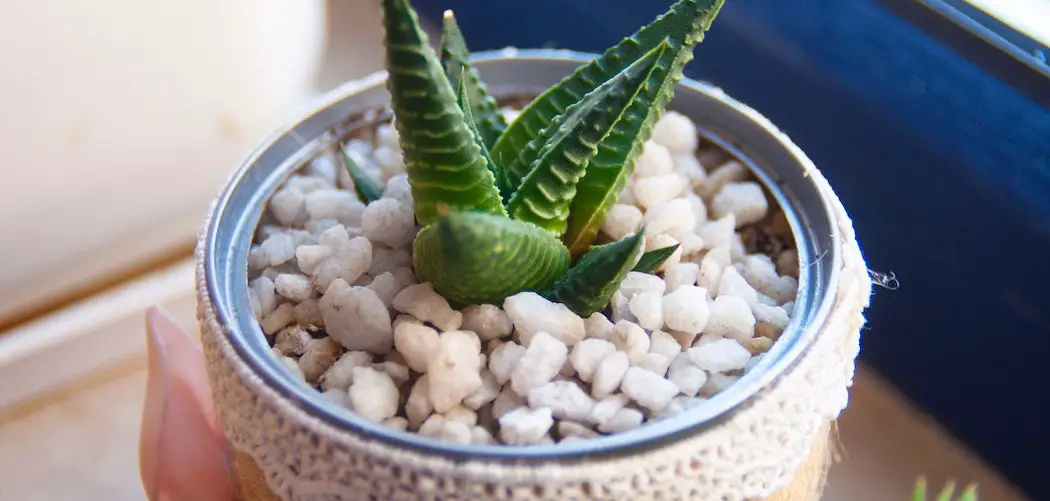There is a lot of confusion and misinformation when it comes to using gravel for houseplants.
Choosing incorrectly could seriously damage your plants, but choosing well will keep your houseplant looking fresh and protect it from things like fungus gnats.
In this article, I am going to tell you exactly what the best gravel for houseplants is, and how to use it.
Here’s The Best Gravel For Houseplants:
Aquarium gravel or pea gravel is the best gravel to use for houseplants, but you can use pretty much any kind of gravel as long as it is the correct size, it’s clean and attractive. Aquarium gravel is ideal because it has already been rinsed, so there’s no need to clean it prior to using it.
Houseplant Gravel Types Explained
Gravel for houseplants can be confusing, as there are a few different kinds of gravel. Also, you might want to choose different options for different plants.
Let’s take a look at a few of the choices that you have, and if they work for houseplants or not:
Aquarium Gravel
Use for houseplants: Yes
Aquarium gravel can be bought from aquatic stores or online, and it might prove a good option if you want to cover the surface of your plant’s soil, or if you wish to pot the plant into gravel.
The advantage of aquarium gravel is that it is already clean and has been washed, so you don’t need to sterilize it or rinse the dust off it before you can use it.
Aquarium gravel also tends to be pretty fine, which gives it an attractive appearance and means it’s easy to pot plants in. They will have enough room to spread their roots and the water should run through easily.
Pea Gravel
Use for houseplants: Yes
Pea gravel is the standard gravel that you might use for houseplants, but it is best to wash it before doing so, as unwashed gravel is likely to be dusty and unpleasant.
You can buy pea gravel from almost any garden center or nursery, or online. It is cheap and easy to source, and it looks pretty in a container.
In general, pea gravel should be small enough to let the water run through and the roots grow, so it will work in most situations.
Pebbles
Use for houseplants: No
You can purchase some very pretty pebbles for your plants and these will make the surface of the soil look neat and tidy, but they may not be so easy to water through, as they are quite large.
They aren’t ideal for growing plants in, either, as they are too big and will not offer the plants much support.
Crushed Granite
Use for houseplants: Yes
Crushed granite works for covering the top of plant pots too, but if you want to grow plants in it, you will need a bit of soil (for most plants) to provide nutrients and keep the plant stable in the pot.
Crushed gravel works decently well, although you should wash it before using it on your containers.
Are Gravel, Pebbles, And Rocks The Same For Houseplants?
No, gravel, pebbles and rocks are not the same when it comes to using them for your houseplants. You can use gravel and smaller pebbles for your houseplants’ containers, but you may find that rocks do not work very well.
It isn’t recommended that you put any type of stones at the bottom of your plant pots, as this can make drainage issues more problematic.
If you are putting the gravel at the top of the pots to keep the planters looking neat and to trap moisture inside the pots, you will likely find that rocks are too big to be practical. You ideally want to create a thick layer, and it’s hard to do this if you are using large rocks.
Pebbles generally fall somewhere in between gravel and rocks, and if you’ve got small ones, they may serve the same purpose as gravel.
However, large pebbles will leave gaps and are not likely to work as well.
Is Gravel Good For Houseplants?
Yes, gravel can be good for houseplants, but it depends on what you want to use it for. In general, gravel serves the following purposes:
-
It makes containers look neat and tidy
-
It stops fungus gnats from getting at the soil and can break their life cycle
-
It is good for plants that need superb drainage
-
It helps to trap moisture in the soil
However, gravel can be bad for houseplants if you use it as a layer for the bottom of your plant pots. It is commonly used to improve the drainage of plants, but this has been proven not to work.
It simply raises the level at which the soil is damp and can actually increase your plant’s risk of root rot.
Do All Houseplants Need Gravel?
No, not all houseplants need gravel, although you can generally put gravel on the surface of the soil without causing problems. Houseplants that prefer damp, marshy conditions may not benefit from having gravel mixed through their soil, because it will cause it to drain more quickly.
It’s always best to do thorough research into the needs of an individual plant before you start adding gravel to its container so you can check whether this would be beneficial or not.
Can You Put Gravel On Top Of Houseplants?
Yes, you can put gravel on top of the soil in a houseplant’s container as a layer. There are a few good reasons to do so, but the most major one is to stop fungus gnats from breeding in the soil.
Adult fungus gnats fly around above the soil and then land and lay their eggs in it. The larvae develop within the soil, spend some time gaining size, and then crawl to the surface and hatch into the next generation of flies.
By covering the soil in gravel, you prevent the gnat larvae from crawling out, and also prevent the adults from accessing the soil.
This breaks the life cycle of the gnats and will kill them off far more effectively than most other methods.
Putting gravel on the surface of the soil also helps to trap moisture within the pot, keeping it available to the plant’s roots for longer.
It reduces evaporation and means you do not need to water the plant as often.
However, you should make sure that you don’t overwater the plant if you have done this, as its roots will rot if you do.
How To Use Gravel For Houseplants
To use gravel for houseplants, you can either mix it into the soil or spread a thick layer on the surface. However, don’t use gravel as an extra layer at the bottom of the pot, that will do more harm than good.
If you want to use gravel to make your houseplants drain better, you may wish to mix it into the soil. You can use a higher percentage of gravel for houseplants that need good drainage, and just a small amount if the plant needs a little bit of drainage.
Gravel works well because it prevents the soil from getting compacted and allows water to run through the bottom. Small gravel is particularly good for making sure that the soil is loose.
The more gravel you use, the more quickly water will run through the plant’s container, so adjust the quantities accordingly. If you find that the plant is drying out too fast, use a higher ratio of soil the next time you repot it, and if you find that it is staying too wet, consider adding more gravel.
Another way of using gravel is to cover the soil of your houseplants in a thick layer of gravel. This will help with fungus gnats as well as give a very nice and tidy look to your plants.
Remember that just adding a layer of gravel at the bottom of the pot will not improve the drainage; you must mix it throughout the potting medium to achieve this effect.
Houseplants That Can Live ONLY In Gravel
There are a few plants that you can grow in just gravel, although most will need additional nutrients if you are going to do this in the long term. Gravel provides a support system that keeps the plants upright, but it doesn’t give them any food.
Here are several houseplants that you can grow just in gravel:
-
Lucky bamboo: this plant will grow in just water and bamboo. It’s tough and it doesn’t need a lot of care or attention. It may eventually need some nutrients added to the water if it is to keep growing.
-
African Violet: this can be grown in just water, but gravel will help to keep the stems upright and anchor the plant securely in its container.
-
Coleus: another plant that will grow well in water, you can prop this up with gravel.
-
Philodendron: if you put the stems of a philodendron in gravel and water, it should survive.
-
Orchids: orchids naturally grow on tree trunks, and will grow happily in gravel if they are given enough nutrients.
-
Tillandsia: these plants grow in air, not soil, so they should thrive when planted on a bed of gravel.
-
Paperwhites: beautiful and delicate, these will grow in just gravel and water.
-
Spider plants: once rooted, you can grow a spider plant in pebbles and water.
- Cacti will grow in gravel as long as they also have some vermiculite or a bit of soil mixed in.
Does Gravel Change The pH Of Soil?
Yes, gravel could change the pH of the soil either up or down, depending on what it is made of. Limestone gravel will raise the pH, and volcanic gravel should lower it. Bear this in mind when choosing gravel for your plants.
Conclusion
Choose pea gravel or aquarium gravel for your houseplants; this will create effective water channels and look attractive on top of a plant’s container.
Don’t use gravel as a bottom layer on your pot, it doesn’t help drainage and could even lead to root rot.

